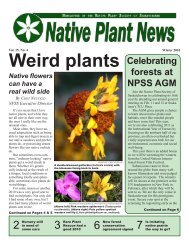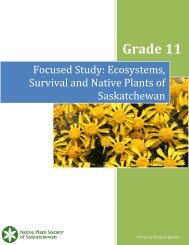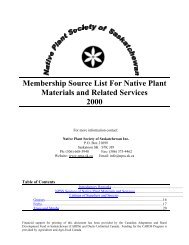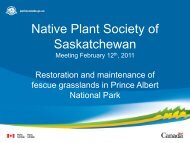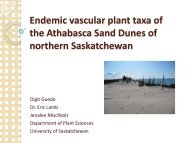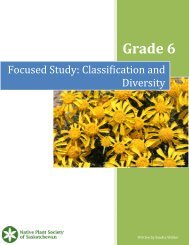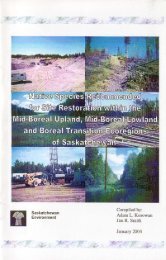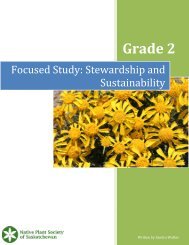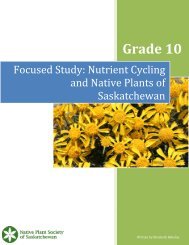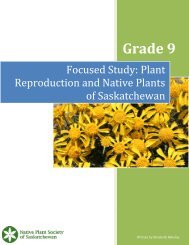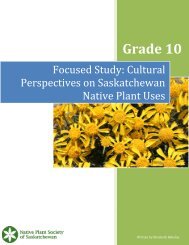Spring 2011 - Native Plant Society of Saskatchewan
Spring 2011 - Native Plant Society of Saskatchewan
Spring 2011 - Native Plant Society of Saskatchewan
Create successful ePaper yourself
Turn your PDF publications into a flip-book with our unique Google optimized e-Paper software.
Vol. 16, No. 1PLAN NOW for the <strong>2011</strong> NPSS summer field tours! Details on Page 3.<strong>Spring</strong> <strong>2011</strong>Photo contest winnersThe Wright stuffSee more photoson Pages 6 to 10Best Overallphoto by Rob WrightStemless lady slipper (Cypripedium acaule).2<strong>Plant</strong>Watchneeds yourhelp this spring4Gardening in5Putting forests12your yard forfirst at <strong>2011</strong>pollinatorsNPSS AGMSpot the prairiecrocus contestis back1
NPSS BoardPresident:Tara Sample 777-9137Past-PresidentMichael Champion 780-6850Vice-President:John Hauer 463-5507Treasurer:Cheri Sykes 924-8007Secretary:Sarah James 787-7603Directors:Leanne Heisler 757-5729Jennifer Lohmeyer 787-8707Margaret Put 921-6361Kerry Hecker 836-2022Shelley Heidinger 634-9771David Engel 472-5988Executive Director:Chet Neufeld 668-3940Newsletter Editor:David Freeman 791-0047<strong>of</strong> DirectorsNPSS Address:<strong>Native</strong> <strong>Plant</strong> <strong>Society</strong> <strong>of</strong> <strong>Saskatchewan</strong>P.O. Box 21099, Saskatoon, SK S7H 5N9Phone: (306) 668-3940 Fax: (306) 668-3940E-mail: info@npss.sk.ca Website: www.npss.sk.ca<strong>Native</strong> <strong>Plant</strong> News is a quarterly publication <strong>of</strong> the <strong>Native</strong> <strong>Plant</strong><strong>Society</strong> <strong>of</strong> <strong>Saskatchewan</strong> (NPSS) and is one <strong>of</strong> the benefits <strong>of</strong>membership. Members are invited to submit articles, news,views, photographs and comments. Views expressed by theauthors are not necessarily those <strong>of</strong> the NPSS.Deadlines: Submission PublicationWinter Issue: November 1 December 15<strong>Spring</strong> Issue: February 1 March 15Summer Issue: May 1 June 15Fall Issue: August 1 September 15Watching for spring’sfirst blossomsBy De a n n a Tr o w s d a l e-Mu ta f o v<strong>Plant</strong>Watch <strong>Saskatchewan</strong> CoordinatorNature <strong>Saskatchewan</strong>It’s hard to believe, but spring is around the corner. Thatmeans <strong>Plant</strong>Watchers all over <strong>Saskatchewan</strong> will be gettingoutside soon to watch the flowers bloom!To become a <strong>Plant</strong>Watcher is very simple – just phoneor email the Nature <strong>Saskatchewan</strong> <strong>of</strong>fice to indicate yourinterest, and we will mail you a package <strong>of</strong> plantwatchinginformation. Then look forone or more <strong>of</strong> the 18 nativeplants or 2 non-nativeplants in your area. You’llwatch the plants, record thefirst bloom and send thoseresults in by mail or email.Even one observation <strong>of</strong> one plant is a great contribution!By signing up as a participant, you will receive twonewsletters per year, including a datasheet to record data andyou can request other <strong>Plant</strong>Watch materials – such as wallcharts, posters, Canada in Bloom booklets and brochures.These materials are also available for download from the<strong>Plant</strong>Watch website (www.naturesask.ca) under Educationand Monitoring.I encourage individuals, school classrooms and naturegroups to get involved in this program as it can be a funproject and is important climate change data.There is also information on the other NatureWatchprograms that may be <strong>of</strong> interest to youth and adults alike –FrogWatch, WormWatch and IceWatch. All <strong>of</strong> these monitoringprograms can be found at www.naturewatch.ca. Besure to check them out!For more information on the program or how to becomea <strong>Plant</strong>Watch participant please call 306-780-9273 in Regina– 1-800-667-4668 outside the city – or email the <strong>Plant</strong>WatchCoordinator at plantwatch@naturesask.ca.If you know <strong>of</strong> a school, youth group or communitygroup who would like a presentation on the program at nocharge, please tell us about them. Happy <strong>Plant</strong>Watching!Membership Dues (Year End November 30 th )Individual $30Family $45Student $15Corporate $200Life $500Please contact the NPSS <strong>of</strong>fice for information about thelifetime membership instalment payment option.2
Gardening for pollinatorsBy Le a n n e He i s l e rNPSS memberAs a prairie enthusiast, I envision apiece <strong>of</strong> the prairies in my own backyard,not only the plants and flowers,but also the sights and sounds <strong>of</strong> bees,butterflies, birds and squirrels goingabout their daily business. Their visitsto flowers are rewarded by the mutualpartnerships that have evolved betweenthem – flowers provide nutrition, whileanimals provide opportunities to completethe plant’s life cycle by dispersingtheir seeds or pollinating other flowers<strong>of</strong> the same species (cross-pollination).Before angiosperms (floweringplants) evolved, cross-pollination wasan affair left to winds and chance. Thisleft a lot to be desired, mostly becausecross-pollination is less likely to occurthe farther away individuals <strong>of</strong> the samespecies are from each other. Thus, plants<strong>of</strong> the same species had to grow in largemonotonous stands, and because therewas no evolutionary advantage to beingcolourful or aromatic, the world wasblanketed in a sea <strong>of</strong> green plants.However, once flowers evolved therace was on to develop these mutualpartnerships between plants and animals,helping plant species disperse andmingle with each other, adding life andcolour to the landscape.<strong>Plant</strong>s use a variety <strong>of</strong> reliable attractantsto entice potential pollinators to visittheir flowers. Bright colors and strongscents are used, while intricate patternsphoto by David freemanA pearl crescent (Phyciodes tharos)butterfly takes a break on a shiningarnica (Arnica fulgens) flower.A bee searches for nectar on a smooth aster (Aster laevis) flower.direct pollinators to what they are lookingfor. Flowers also produce nectar, extrapollen or other nutritious tissues to feedpollinators and lure them into the flower.Some plants use these tools toencourage visits from everything whizzingby the flower, or they may use oneor a few specific techniques to lure ina certain species. When a flower hasadapted to attract a specific species <strong>of</strong>pollinator, the pollinator will also evolvesearch images for that species’s flowerand other structures to aid in collectingwhatever it retrieves from those flowers.By knowing what bees, butterfliesand birds are searching for, a gardenercan actually use their flowers to lurepollinators into their backyard.Using plants native to your surroundingsis a good way to attract thelocal wildlife, as most <strong>of</strong> these speciesevolved together.For instance, bees prefer blues andviolets, but will visit white, yellow andpink flowers if they discover an abundance<strong>of</strong> delicious nectar there. Someplant species preferred by bees andnative to the Canadian prairies includegiant hyssop (Agastache foeniculum),purple prairie clover (Dalea purpurea)and northern hedysarum (Hedysarumboreale). Butterflies will visit a variety<strong>of</strong> flowers, like black-eyed susan (Rudbeckiahirta), dotted blazingstar (Liatrispunctata), gaillardia (Gaillardia aristata),smooth aster (Aster laevis), prairie4photo by david freemanIn my garden right nowit is high summer, themiddle <strong>of</strong> July, and theplace is so crowdedwith flowers, is sobusy and multifarious,that it feels more likea city street than aquiet corner <strong>of</strong> thecountryside.– Michael Pollan, Botany <strong>of</strong> Desireconeflower (Ratibida columnifera), stiffgoldenrod (Solidago rigida), yarrow(Achillea millefolium), wild blue flax(Linum lewisii) and yellow eveningprimrose (Oenothera biennis). Birdswill be attracted to shrubs that producenutritious berries (strategy for seeddispersal, rather than cross-pollination),such as saskatoon (Amelanchier alnifolia)or chokecherry (Prunus virginiana).The best way to ensure a wide variety<strong>of</strong> pollinators visit your garden is byplanting an equally wide variety <strong>of</strong> nativeshrubs and flowers – from large to small,tubular to flat and broad, scentless to aromatic,as well as an assortment <strong>of</strong> colours– ensuring that an array <strong>of</strong> wildlife willbe attracted to your yard.
Roughly 100 people attended the <strong>2011</strong> NPSS AGM in Saskatoon in February.photo by Chet neufeldAGM draws large crowdsBy Ch e t Ne u f e l dNPSS Executive DirectorThe NPSS held its annual generalmeeting and workshop at TCU Placein Saskatoon on Feb 11 and 12, and incelebration <strong>of</strong> the International Year <strong>of</strong>Forests, the society focused on forestrelatedtopics.The event began on Friday nightwith a screening <strong>of</strong> winning films fromthe International Forest Film Festival,which had premiered at the UnitedNations in New York only the weekbefore. It was a prestigious honour to beone <strong>of</strong> the first venues in North Americato screen these films outside <strong>of</strong> thepremiere!Keynote speaker John Murray sharedwith us the splendid ecological, culturaland social value that exist – to thisday – in <strong>Saskatchewan</strong>’s boreal forest.Through his words, photos and music(featuring Stanley the singing saw) heshowed us how much impact forests andour treatment <strong>of</strong> forests can have on ourwell-being. We learned what it meansfor children to connect with nature forthe first time and the heartbreak sufferedwhen poor forestry practices change atraditional way <strong>of</strong> life forever.Saturday’s presentations wereequally exciting.Janna Lutz introduced us to eco-buffers,a new type <strong>of</strong> dense native plantingdeveloped by the AESB Agr<strong>of</strong>orestryCentre. I’m sure you’ll hear more abouteco-buffers in the years to come.Jeff Weir discussed the restorationand maintenance <strong>of</strong> fescue grasslandsin Prince Albert National Park. Hopefullywe’ll be able to experience thislandscape first hand during our summerfield tour there later this year (see Page3 for details).Digit Guedo spoke about the endemicplants <strong>of</strong> the unique AthabascaSand Dunes. It was fascinating to learnabout the 10 endemic species that callthe dunes home, and the unique evolutionarycharacteristics they developed tosurvive in such a special ecosystem.In the afternoon, Jill Johnstone spokeabout how climate change impactsthe boreal forest. As climate changebecomes a more controversial topicit’s interesting to consider how it willaffect the vast tracts <strong>of</strong> <strong>Saskatchewan</strong>boreal forest in the future. MichaelMcLaughlan followed with a presentationon the new Field Guide to theEcosites <strong>of</strong> <strong>Saskatchewan</strong>’s ProvincialForests. Not only was it a very interestingtalk, but everyone also receiveda free copy <strong>of</strong> the field guide – a $35value!On Saturday afternoon, we concludedwith a workshop on how tocreate wildlife habitat in your yard usingnative plants. Participants learned aboutwhat species to use as well as sometechniques to improve wildlife habitatand biodiversity.Overall, the workshop was a greatsuccess. All <strong>of</strong> the speakers were excellent,the film festival was a hit and Ireceived dozens <strong>of</strong> comments sayingthat this was the best annual general5meeting in a long time (some said it wasthe best ever). It was also one <strong>of</strong> thebest attended in years, with nearly 100people attending. AGM presentationscan be downloaded from our website,www.npss.sk.ca.The interest in the member slideshow was spectacular. The stage wasliterally flooded with people wanting toshare their photos. We had so many photosthat we went right through lunch andeven showed photos during the secondc<strong>of</strong>fee break! It was really good to seeso many enthusiastic members and trulyenjoyable to live vicariously through allyour plant adventures.But the AGM isn’t just about learningand discussing interesting topics andhaving a good time. There was businessto attend to as well.Nora Stewart was presented with thesociety’s Volunteer <strong>of</strong> the Year Awardfor hosting a native seed collectionworkshop last fall and Rob Wright waspresented with the award for the NPSSPhoto Contest (see Page 1, 6 and 7) – aCanada Post stamp with his photo <strong>of</strong>a stemless lady slipper (Cypripediumacaule). The stamps are for sale on ourwebsite, www.npss.sk.ca.Of course, this event could not evenhappen without the generous support<strong>of</strong> our sponsors: Environment Canadasponsored the workshop component;SaskEnergy was the carbon neutralsponsor; Nature <strong>Saskatchewan</strong> providedoverall sponsorship; and the MeewasinValley Authority and Margaret Put eachsponsored a c<strong>of</strong>fee break.
<strong>2011</strong> NPSS Photo ContestHonourable Mentionphoto by sarah vingeThe underside <strong>of</strong> a gaillardia (Gaillardia aristata) on a summer day.About the contestLeanne Heisler, Rik Anaka, and Don Fontainechose the finalists and passed them on to pr<strong>of</strong>essionalCanadian nature photographer John E. Marriottto choose the Best Overall photo for 2010.The Best Overall photo came down to twoby Rob Wright: the sphagnum and feather mossyou see on the right and the Stemless lady slipper(Cypripedium acaule). Ultimately, the lady slipperphoto was chosen.The winning photo (front cover) was printed ona Canada Post postage stamp that is now availablefor purchase on the NPSS website.Thanks to the judges for all their hard workand for making some very tough decisions. Enjoythe winning photos and some <strong>of</strong> the best <strong>of</strong> thebunch on the following pages.For more on photographer John E. Marriot,visit his website, www.wildernessprints.com.Sphagnum and feather moss.6Second Placephoto by Rob Wright
Best overallphoto by sarah vingeLance-leaved stonecrop (Sedumlanceolatum).photo by Jen RumancikStriped coralroot(Corallorhiza striata).photo by Glen LongpreEnglish sundew (Droseraanglica).photo by Jen RumancikA yellow ambush bug (Phymata sp.) sits in wait <strong>of</strong> preyon goldenrod (Solidago sp.).7One-flower wintergreen (Monesesuniflora).photo by Jen Rumancik
Runner-Upphoto by Jen RumancikA prairie sunset over Jackfish Lake.Sceneryphoto by Jen RumancikThe setting sun gives this prairie rivervalley a beautiful golden glow.photo by Sarah vinge(Left) A lone sunflower(Helianthus sp.) rises from thewet sand along a shoreline.8
photo by Glen LongpreA lesser yellow lady’s slipper (Cypripedium parviflorum).<strong>Plant</strong>sphoto by Sarah VingePrairie Coneflower (Ratibidacolumnifera).photo by Jen Rumancik(Above) The male flower <strong>of</strong>arrowhead (Sagittaria sp.).photo by Fidgi Gendron(Left) Purple prairie-clover(Dalea purpurea).photo byJen RumancikCut-leafanemone(Anemonemultifida).photo by Fidji Gendron(Above) Rosy pussytoes (Antennaria rosea) reaching for the sky.photo by rob wright(Right) The happy, yellow face <strong>of</strong> a marsh-marigold (Caltha palustris).11
Monarch butterflyworkshop plannedCorporate Members and PartnersA monarch butterfly (Danaus plexippus).photo by david freemanThe Winnipeg Chapter <strong>of</strong> the Monarch Teaching Networkis planning to host a workshop in Regina on July 19 and 20.Learn how to use the journey <strong>of</strong> the monarch butterfly toenhance your success in the classroom.The Monarch Teacher Network is a group <strong>of</strong> teachers andeducators in North America that use the monarch butterflies as ateaching and learning tool in their classrooms. The epic journey<strong>of</strong> the monarch butterfly can help in teaching science, art, mathand more – in a fun way that engages children to learn.Teachers wishing to participate should come forwardbefore the end <strong>of</strong> June.Please note that there is an early registration discount!For more information visit www.monarchteachernetworkwesterncanada.com.Spot the crocus contest is back!I know that there’s still a lot <strong>of</strong> snow around and it doesn’treally feel much like spring, but it won’t be long before theprairie crocuses (Pulsatilla patens) start popping up. Sometimesthey will even force their way through a thin layer <strong>of</strong>snow if conditions are right.That’s where you come in. Keep your eyes peeled andwhen you spot the first crocus <strong>of</strong> the season, let us knowabout it. You can even include a picture <strong>of</strong> it.The winner will receive bragging rights for the year anda mention in our newsletter. All submissions will also besent along to <strong>Plant</strong>Watch, a program which helps to monitorclimate change.RETURN UNDELIVERABLE CANADIAN ADDRESSES TO:<strong>Native</strong> <strong>Plant</strong> <strong>Society</strong> <strong>of</strong> <strong>Saskatchewan</strong> Inc.P.O. Box 21099Saskatoon, SK S7H 5N9TO:Canada Publication Mail Agreement #4003590912



